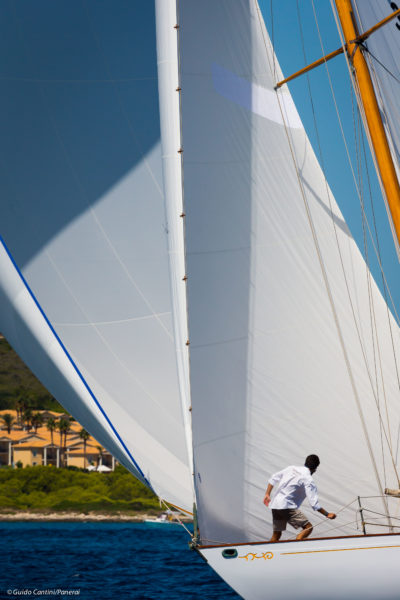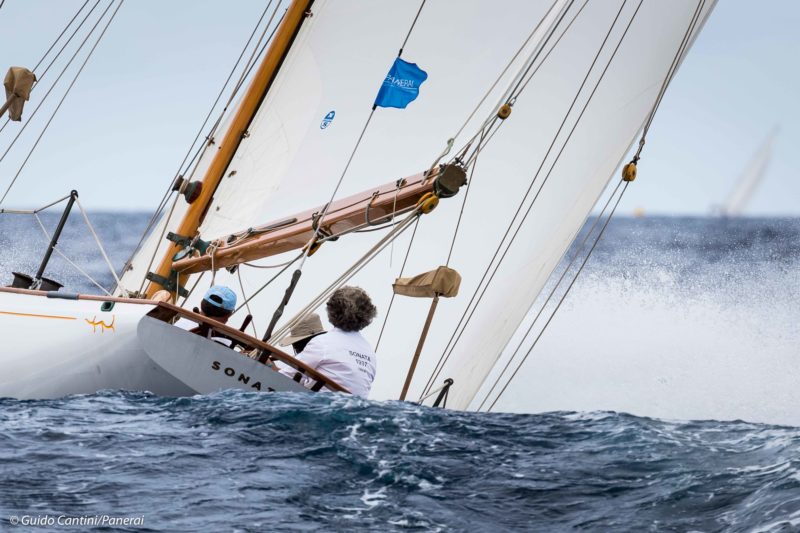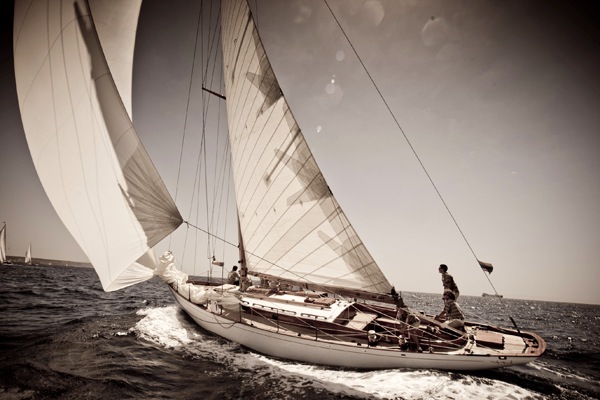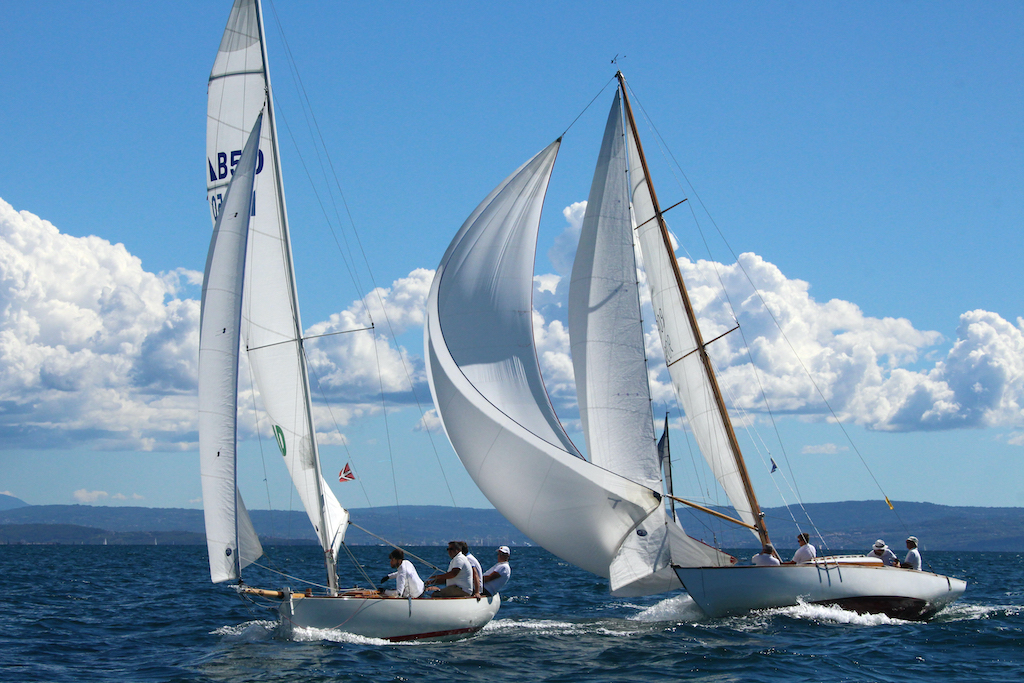



An article by Sonata owner Jordi Cabau from fundacionhispania.org
SONATA, another member of the family
Having finished restoring Mercury and after some extraordinary experiences with the boat over three years, at both the cruising as well as a racing level, I heard that a boat with characteristics similar to Mercury was being restored in Palma de Mallorca.
I was happy that somebody else was passionate about this type of boat and that soon we would see a new boat join a short list of jewels that are still being sailed today. I also thought if she was like Mercury, as they were saying, I would soon have a new rival with which to compete. Several months ago and by chance, I came across the person who had mentioned this boat in the shop of Mateo Gimalt, who restored Mercury. He told us again about the boat and that the owner had decided to stop restoration and had put her up for sale.
Given the proximity of where the boat was, we decided to take a look at her, just out of curiosity and to see if she was really as much like Mercury as they said. The boat was in the Son Vida housing development, specifically in the garden of a house in the middle of the mountains and surrounded by a beautiful golf course. When we arrived there I thought it was a strange place for a boat and then I saw a wood hangar covered with plastic. We opened the door and there inside, resting on some posts with its bow directed towards me, was the majestic boat we had come to see.
I admit that I stood for a few moments absolutely surprised for various reasons: first of all, I had never expected to find a boat like that in such a place, secondly I was taken by the fantastic lines of the boat and finally because, at first sight, she had a lot in common with Mercury. Obviously, she was in deplorable condition but from previous experience I could already see how she would turn out.
The original plans of the boat were hanging on a wall signed by John Alden. I studied them at length and realized how beautiful the boat could be if she were restored. I looked at Mateo and said to him in Mallorqui “qué es de guapo aquet barco” (This boat is beautiful). He agreed and kept looking at the work that they had done and the condition she was in.
When we left there I could not stop thinking about the boat. I already had one and to get involved with another would be difficult but it would be a shame to let such a beautiful boat get away. I debated with myself while thinking, how was it possible that a couple years earlier I was looking for a classic boat and finally found one in Mallorca (see the article published in the Fundación Hispania no. 7 of 2003) and now I would find another only a couple minutes from my house?
What a coincidence that the two should be designed and built in Boston, Massachusetts, so close to one another seventy something years ago. Mercury was built by Sam Crocker in 1938, who worked for John Alden for many years and this one by Carl Alberg in 1937, designer for John Alden. There were many coincidences. Fate must have wanted these two boats to put into port in Mallorca seventy years later and thus cross my path. So I did not hesitate, I knew perfectly well what I was getting into after my experience with Mercury when I acquired a piece of that value and the condition that the boat was in. After consulting with my family and obviously Mateo, since he was the one that was going to have to restore her, I made contact with the owner to negotiate the purchase of the boat. A few days later I was the new owner of the boat that was going to be the new Sonata.
I made an agreement with the previous owner to carry out the restoration of the hull in the same place I found her since, given its condition, it would have been impossible to move her without destroying it. We agreed to keep her there for a year until the structural work on the hull was completed and that is how we started restoration of Sonata.
Sonata is project number 648 of the prestigious American naval architect John Alden. She was designed by Carl Alberg in 1937 and built in Boston, Massachusetts in the F.F. Pendleton shipyards. She is a cutter sloop, 15 meters in length, with 3.60 meters in beam and 1.95 meters height from keel, ideal for shallow waters. She has 15 tonnes of displacement of which 6 are in ballast and a sail surface area of 114 square meters.
Structurally speaking, she is built with the so-called double hull with keel and classic ribs. On this is a double lining of planks making 32mm of thickness that are covered so that its seams do not provide openings, thus eliminating the need for caulking. The first interior lining is of red cedar and the second of marine mahogany. This lining is connected with the keel by several 40mm thick solid mahogany garboard strakes attached to the keel by caulking. The Alden design has harmonious shapes and very delicate sheer. The American was a master at creating vanishing lines between this curve, the cambers of the deck and deckhouse and the different elements of the tackle resulting in incomparable harmonies.
Deck beams, brackets, sleepers and other pieces of the topside were selected, restored, reinforced or replaced depending on their condition. New bronze rungs were cast and several bolts were replaced from those that held up the ballast.
Below water the hard work was cleaning the keel of reasonable draft and ribs in the shape of a wine glass typical of the designer, wide in beam but without reaching the extremes of Herreshoff. The entire interior was taken apart to get to the superstructure and reach the ribs while keeping all the wood that we found intact.
The crescent shaped rudder is stuck behind the keel with a tilted rudder stop that reduces the wet surface area. The whole rudder system could be kept with the transmission system of the helm port to the rudder stop being of cast bronze.
The deck is notable for its oval cockpit, another one of Alden’s characteristic traits along with the limbers done in the escutcheon. The superstructure forms a perfect marriage between flat and curved elements in an intelligent play with masculine and feminine. The harmonious curves of the coaming, almost vertical, where the passenger backrest is located, goes together with a rudder box housing the traditional system of transmission by the original sprocket wheel made of cast bronze.
There is a deckhouse with an entrance moved to starboard, also common in many of the North American’s designs, which contributes to giving the boat her special character. The volumes marked at 90 degrees are reinforced by a coach roof that appears flat although it is given the corresponding camber to make a very clear aesthetic statement, no ornaments, the simpler the better. There are no edges to be seen anywhere since all the angles have a radius and even the coach roof or the coaming are finished with discrete half-round lids.
In her interior Sonata demonstrates a mixture of marine rigour and superficial luxury that was the style in the nineteen-thirties. The distribution of the original design has not been modified at all. The bunks are narrow, practical and come with rails. The benches in the lounge have a marine table and an adjustment for list. The kitchen is to the bow of the mast leaving space for a small cabin and anchor well. To stern, making use of the side casing, there is a central passage to a well-furnished stern cabin. A spacious bathroom area recreated with classic pieces and fixtures is also located there.
There is no lack of ornamental elements, like the leaded glass in the lounge closet and another in the galley. We used similarly coloured mahogany in the restoration as that found in the original. To our amazement, we were able to achieve a blending of the new pieces with the original that was in perfect harmony with one another.
As I mentioned at the beginning, finding two boats built in Boston in 1937 and 1938, so close to my house, is too much of a coincidence to not talk about fate. When I saw Sonata for the first time I knew that her beauty had to be saved, but I admit that I committed myself to a sailboat without really knowing how she would sail. The eighteen months became three years of work that was done slowly and with limited human resources. Mateo Grimalt supervised most of the work and the rest, such as painting, varnishing and equipment, was done by me with the help of family and friends.
I was able to get all the original plans and parts from the Alden Company and I even went to Boston, where they still have their offices, to share the restoration work with them. As a result I was able to maintain perfect fidelity to all the details. They even gave me a copy of the original buyer-seller contract of the first buyer with all of the details and extras for the boat when she was built.
Sonata has had various owners over the last seventy years and has changed names on numerous occasions, the last and the one which she had when I bought her was Hesperus and just like I did with Mercury I gave her back her original name.
At the time that we were finishing the boat we were still thinking about the mast, the hardware and the sails. We replaced the short and ungraceful aluminium mast that some previous owner had used with an Alaska Pine mast made by the English company Noble in accordance with the original design. A lot of the ironwork like stanchions, winches, cleats, blocks, eyebolts, rails, etc., all originally made of bronze by the Merriman Company were reused and others had to be ordered through the German company GD Boote who can do any kind of job related to casting bronze. All this was done to such purist craftsmanship that even the crank winches are the traditional ones without any kind of clamp.
Obviously and after the experience I went through with Mercury, besides having a beautiful boat, I wanted her to be competitive. Therefore, I took special interest in the design of the sails. They had to be traditionally short with tight cloth and finished in leather but at the same time of the highest quality. The sails are the engine of the boat.
For me, competition among classic sailboats is something more than a show. It is a place to develop, where one boat improves another. Each one has its place; those that want to win put more effort into it. Those that are happy just to participate also have their role.
I also have to clarify that although between Mercury and Sonata there are many things in common, which is logical since they were both built within the same period and same place, under similar design guidelines, they sail completely differently from one another. Each has her own personality, perhaps Sonata is lighter and tighter but Mercury maintains her sobriety and elegancy on the sea and on open course all her potential comes out, making it hard to keep up with her.
I have to say and admit that what I did not expect was to win the Trofeo Almirante Conde De Barcelona on Sonata’s first outing. Not only did we win the racing field but we were also recognized for all the effort done during those years in returning Sonata to all her previous splendour by also winning the trophy for best restoration.
All this makes me think of how it was love at first sight and that all the sacrifices that followed were completely worth it. I am proud to have recovered this jewel from sailing history and can now add her to a select group of boats from that era.
Jordi Cabau, Owner of Sonata








